Highlights of Route 66




with Archers Holidays, June 2015





Bleagh! This was the first proper day of our cross country trip as today we hit the road. Bags had to be ready for 6.30am (ew!) and we were due to leave at 7.30am when we met in the lobby.
We boarded the bus about 7.45am and were introduced to John, who would be our driver for the rest of the tour. We were told to sit anywhere - the seats seemed a reasonable size and with a leather-look they seemed a little posher than some buses we've had. Even better, they had power at the seats to keep my assistants working on my trip notes as we travel, in the hope of making my write-ups quicker to publish. Doubtful. Another plus was that on this bus we would have Wi-Fi. Not all the time, sadly, but where it was available to the bus we would be able to use it so I could tweet on the road! Woohoo. Well, I have my American phone too.
We set off. The skies were pretty grey when we left Chicago and, as we travelled, it got darker and darker until we were driving through torrential rain, with the occasional flash of lightning. It was looking a little apocalypse-like, but heck, we were on the bus, what did we care? Gotta love a Faraday cage, right? (Oh, go look it up!)
Our first stop of the day was at Pontiac, Illinois. We arrived at about 9am and had seventy-five minutes so we were a little rushed, but it's certainly motivating!
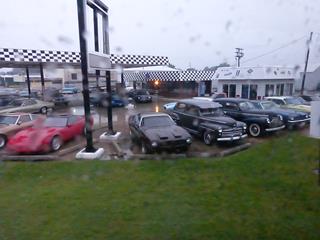
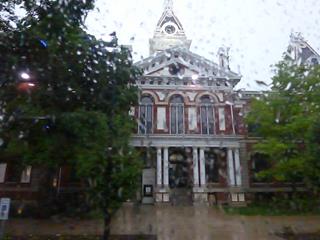
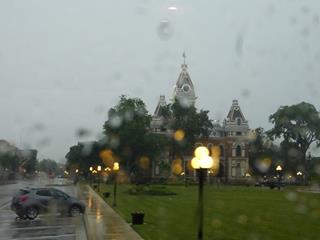
We entered the Illinois Route 66 Hall of Fame Museum

 and a man in there told us to check out the Lingston County War Museum
and a man in there told us to check out the Lingston County War Museum


 upstairs. It turns out he was David Estes, son of one of the founders, Dal Estes (below left). Seeing most people were staying to look downstairs, we headed upstairs to the War Museum. They had a huge collection of uniforms, many donated by local residents who had served in the military, or by their families. Many had the story of the previous owner so you could read about the person behind the uniform. It certainly made you think.
upstairs. It turns out he was David Estes, son of one of the founders, Dal Estes (below left). Seeing most people were staying to look downstairs, we headed upstairs to the War Museum. They had a huge collection of uniforms, many donated by local residents who had served in the military, or by their families. Many had the story of the previous owner so you could read about the person behind the uniform. It certainly made you think.
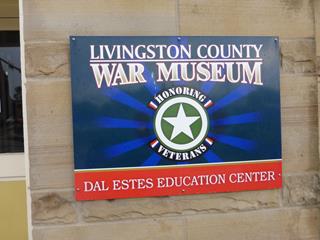
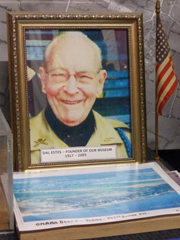
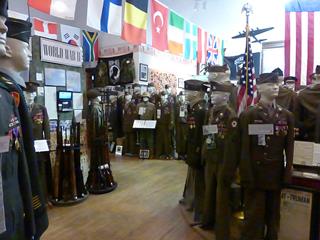
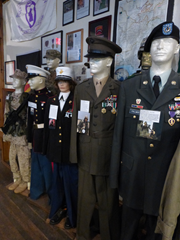
The cupboards were full of model aircraft. I found a couple of army bears so I stopped to have a chat with them.
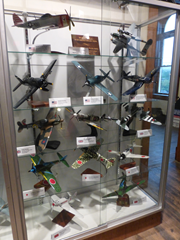
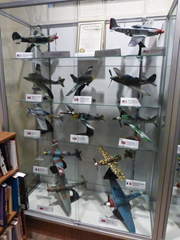
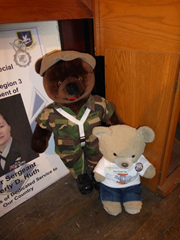
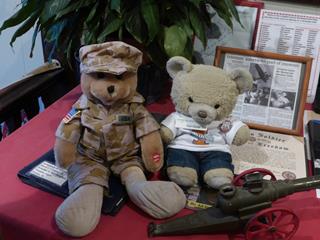
They had a model of the USS Floyd County, used by the military in the World War II, Korea and Vietnam conflicts. They had a number of weapons on display too. They also had larger model aeroplanes hanging overhead.
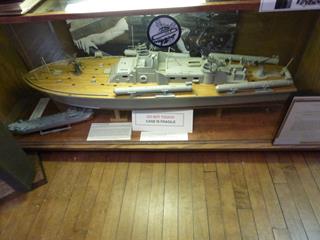
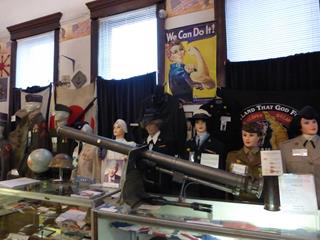
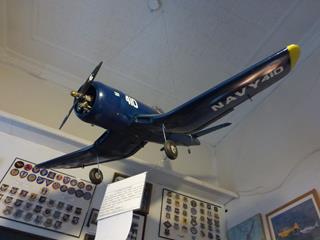
It was certainly worth a look - shame we didn't have more time - but it was helpful having a personal tour of part of the museum by someone so close to it.
They have a 1940s house in another part of the museum - I suspect Ancient Assistant Noreen will remember some of these items!
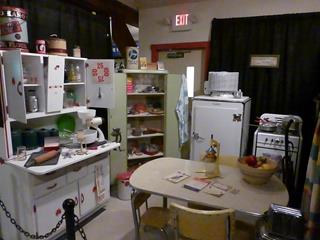
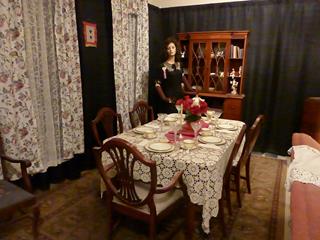
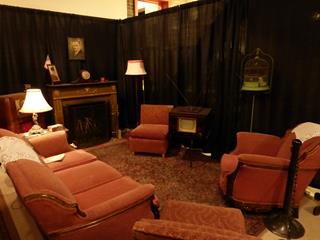
We found a washroom and again found out how flatties are made... They also have a mock up of a 1960s AM radio studio (below right).
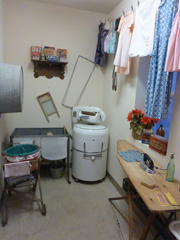
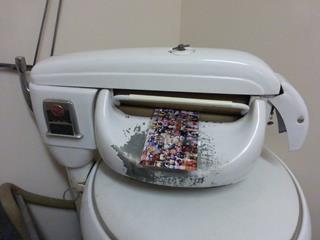
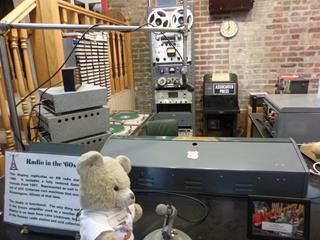
We heard some music playing and when we entered it was a mockup of the Stage Door Canteen, a New York canteen where Servicemen on leave would visit. It was open from 1942 to 1945, offering free food, dancing and entertainment, served by movie stars. You could dance with the likes of Lauren Bacall or Bette Davis, listen to Bing Crosby sing or Benny Goodman play. They had instruments set up on the stage, which musician Paul found interesting as he likes old instruments.
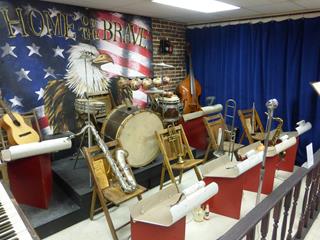
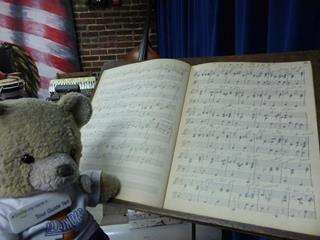
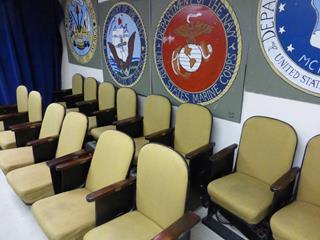
We finished up downstairs in the Route 66 Hall of Fame Museum, as by now everyone else had cleared out! There was a fairly small selection of artefacts for Route 66. It was a little eclectic.
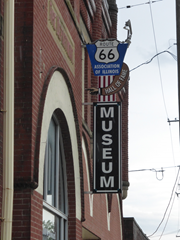
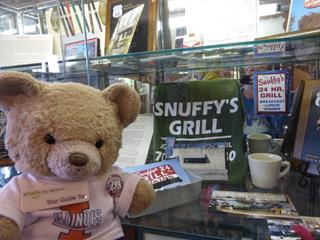
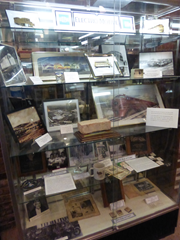
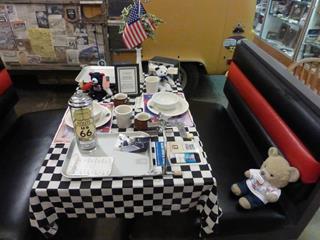
They also had Bob Waldmire's VW Campervan. As a great fan of Route 66 he travelled the road in this van. This van served as the model for Fillmore in the PIXAR film Cars.
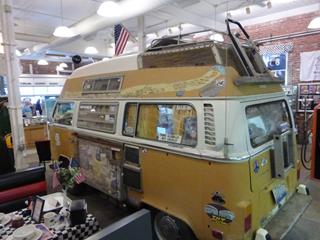
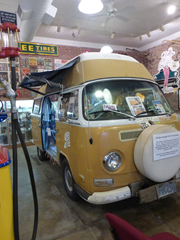
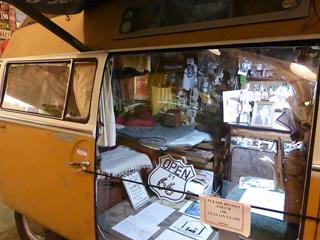
We wanted to see some of the murals that had been painted in town so headed out into the rain. There are more than twenty outdoor murals depicting local history and culture.
We soon found the first of a number of miniature cars around the town (they have fifteen - 10 '57 Chevys and 5 pickup trucks) so I sat in a few, though it was raining and someone who shall remain nameless (Di) had left my flippin rain poncho in her case on the bus, so I got a bit damp! Again.
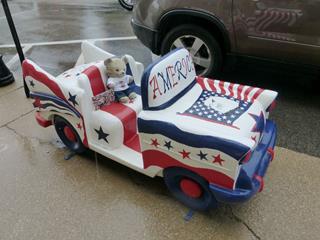
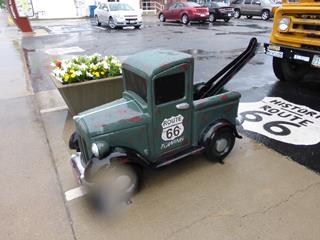
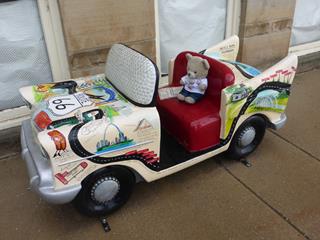
Around the back of the museum was the largest Route 66 shield in the world and is one of Pontiac's oldest murals. There is an area in front of the shield paved with bricks used in the original Route 66 and folks can apparently drive their car up in front of the mural to take photographs. Don't think it would work so well with the bus!
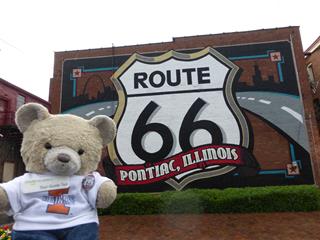
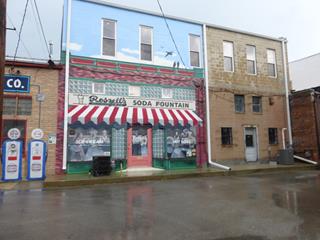
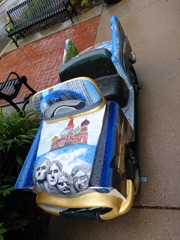
We headed across the town to the Pontiac-Oakland Museum.


 This is a free-to-enter (donation appreciated) museum which houses one of the largest collections of Pontiac and Oakland automobiles and branded items. They even have a display of over 2000 oil cans! It seems they regularly change the displays so you can usually see something new.
This is a free-to-enter (donation appreciated) museum which houses one of the largest collections of Pontiac and Oakland automobiles and branded items. They even have a display of over 2000 oil cans! It seems they regularly change the displays so you can usually see something new.
Here we have a 1931 Oakland Sport Coupe, a 1980 Firebird - Special Yellow Bird Edition and a 1976 Pontiac Trans Am - 50th Anniversary Edition.
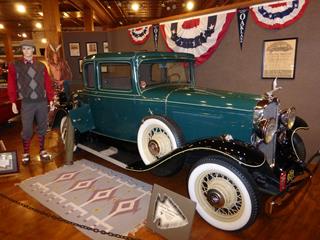
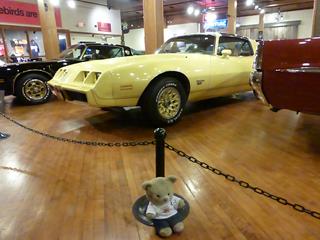
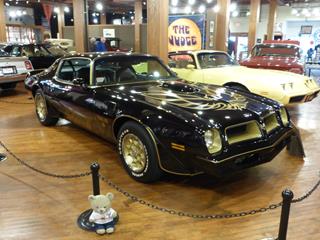
Check out this little Pontiac Pace Car - I was hoping to steal it, but seems they frown upon that kinda thing! Who knew? Below right is the full-size 1984 Fiero Indy 500 Pace Car.
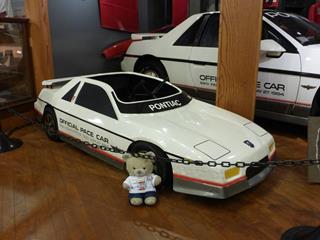
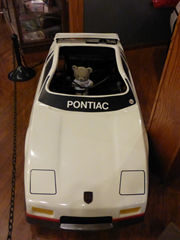
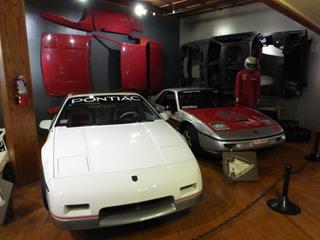
1934 Pontiac '8' Sport Coupe, an 1890s Pontiac Buggy (one of only two known to exist) and a 1929 Oakland Roadster.
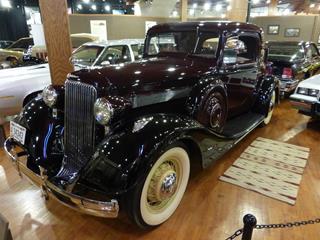
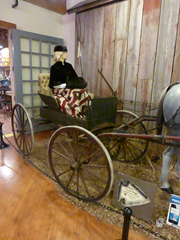
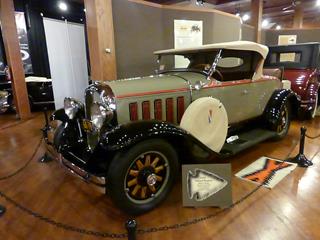
A 1926 Pontiac Coupe - the first year of motor car production for Pontiac (below left). They have a pretty large collection of Hood Ornaments (below centre) as well as a variety of other Oakland and Pontiac branded items (below right).
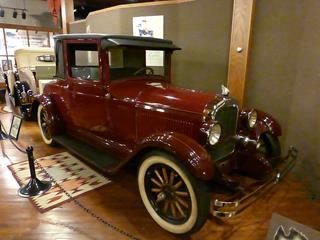
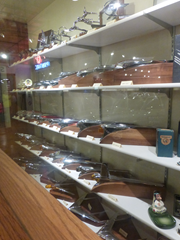
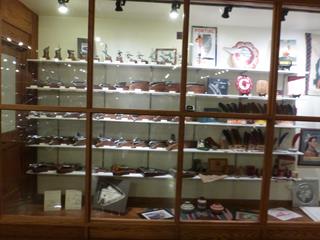
They didn't have a lot of stuff in the shop - a few t-shirts and sweatshirts, badges and magnets, but not very much. Still, it was a good museum with a lot of cars to see and no entrance fee, though folks can make a donation. We could have spent longer in here - especially assistant Paul - but we were rushing to see everything in the time we had.
When we came out of the museum, the rain had eased so we headed back to the Route 66 sign to get some more pictures.
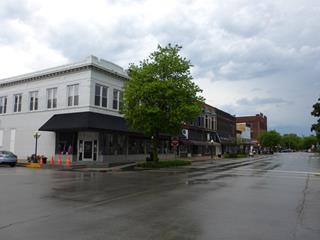
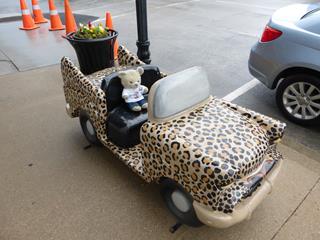
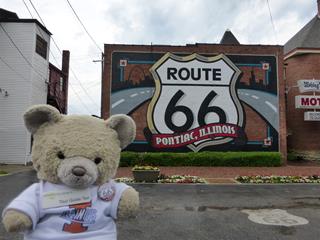
Near the mural, around the back of the Route 66 Museum is the School Bus Road Yacht - another camper van of the late Bob Waldmire. You can take a look inside of this but we only had three minutes to get back to the bus so we pretty much dashed on and off again. The bus is a converted school bus and Route 66 fans consider it a highlight. There is a lot of stuff crammed in this bus and I'd hate to think what would happen to it all if he did an emergency stop!
Bob took Route 66 with his family from Springfield, Illinois (our next stop) to California in 1962 and fell in love with the Mother Road. He spent the rest of his life travelling the road, funding it with his artwork. In 1987 he aquired this 1966 School Bus and is now how it was when Waldmire died in 2009, containing mementoes of his life on Route 66.
We were about to return to the bus (right on time) when we realised they'd moved it round the corner (trying to lose me?) but we spotted it (ha!) and got on board.
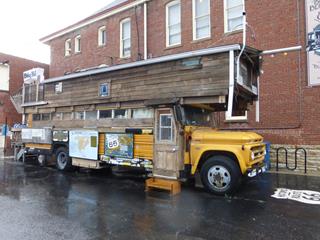
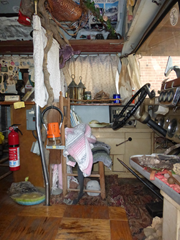
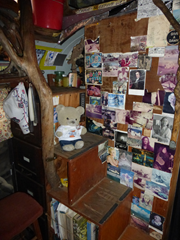
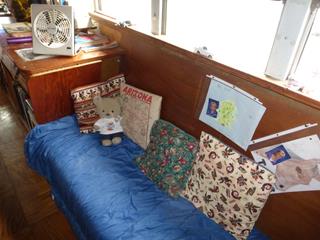
The bus set off then for Springfield, Illinois (nothing to do with the Simpsons), which was about an hour away. This would be our stop for the rest of the day. We arrived in Springfield around 12.30pm and had a stop for lunch. The bus parked outside a Panera Bread



 restaurant and, as we'd heard great things about the chain, but never tried it we went inside (wasn't much else to do). I ordered a grilled cheese sandwich, chocolate chip cookie and a latte.
restaurant and, as we'd heard great things about the chain, but never tried it we went inside (wasn't much else to do). I ordered a grilled cheese sandwich, chocolate chip cookie and a latte.
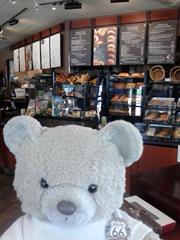
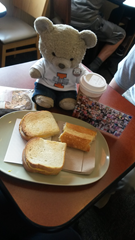
We got back on the bus for the short drive over to the Lincoln Home,



 - a National Park site. They had some pictures of the house as it was during Lincoln's Funeral (below centre). We had a few minutes to hit the gift shop where I bumped into Mary Todd Lincoln and Abraham Lincoln (or was it the Child Catcher from Chitty Chitty Bang Bang?)
- a National Park site. They had some pictures of the house as it was during Lincoln's Funeral (below centre). We had a few minutes to hit the gift shop where I bumped into Mary Todd Lincoln and Abraham Lincoln (or was it the Child Catcher from Chitty Chitty Bang Bang?)
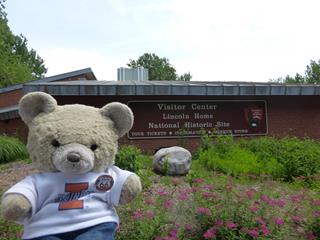
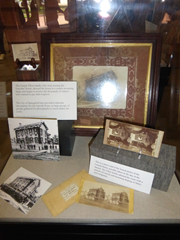
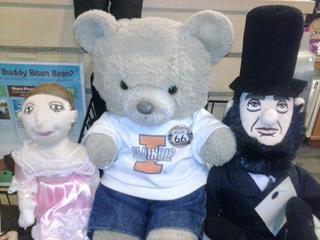
Wow what a change in the weather. Since we left a rainy Pontiac, it was now a bright, sunny day in the 80s! (Fahrenheit). It was sooooo hot. We all grouped under the shade of some trees while one of the National Park Rangers split us into three groups to go through the house. They were a bit strict on not hanging about inside the house as we did the tour and not touching ANYTHING (including the walls and doors) but we were allowed to take photographs so we did the best we could.
The Front Parlour was where Lincoln would entertain visitors and conduct business. It was designed to impress and show off their social status, decorated with wallpaper and coloured carpets as well as elaborate furniture.
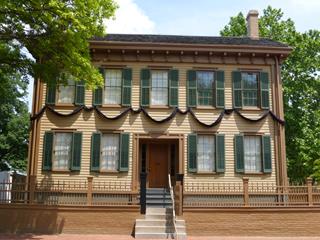
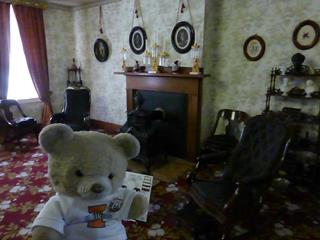
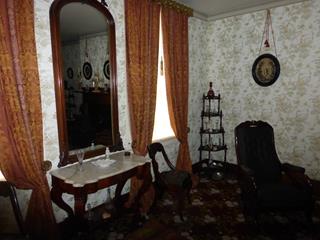
In the Back Parlour, Lincoln had his office/study. It was here that he received an offer of the Republication Nomination for President, in 1860.
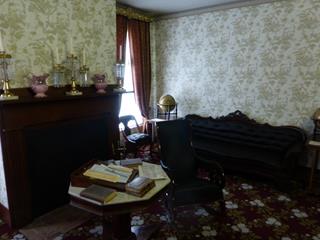
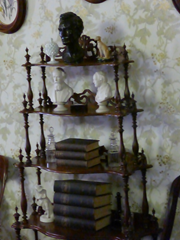
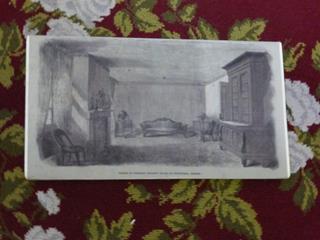
Below left is the Dining Room. The dinnerware is similar to that owned by the Lincolns. The Sitting Room (below centre and right) was for informal family gatherings with the children, dog Fido and numerous cats.
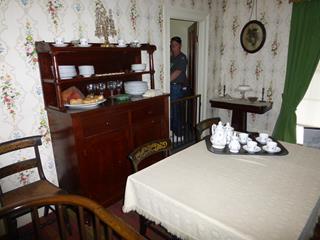
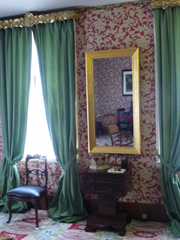
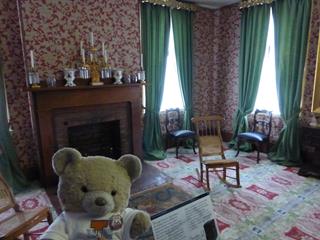
We headed upstairs where we were allowed to touch the handrail that the Lincolns would have used. This is the Guest Room and the sleigh bed in here is the only bed in the house that originally belonged to the Lincolns.
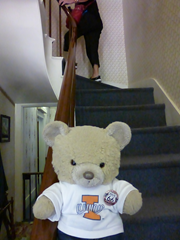
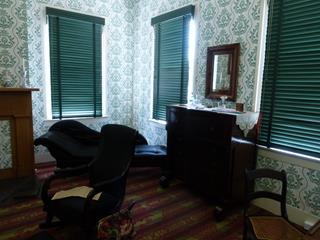
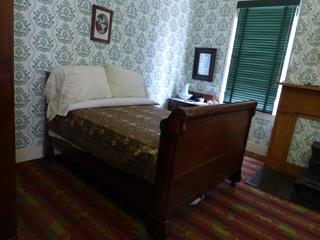
We saw Mr Lincoln's Bedroom from 1855 to 1861. It was considered a luxury for Mr and Mrs Lincoln to have separate bedrooms. The small desk (below centre) belonged to the Lincolns and Mr Lincoln may have written some political speeches at it.
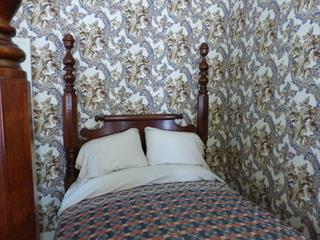
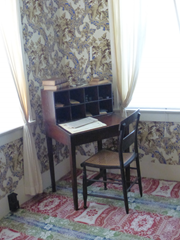
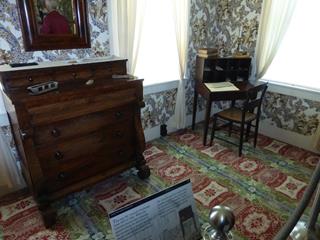
Next was Mary Lincoln's Bedroom, separate from Lincoln's which was an indicator of status or wealth and not a poor marriage, by the way. The Boys' Room was used by William "Willie" and Thomas "Tad", once Robert had left home to study law. It is said that the Lincolns were fairly indulgent with their children, to the dismay of the neighbours.
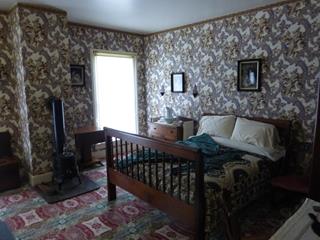
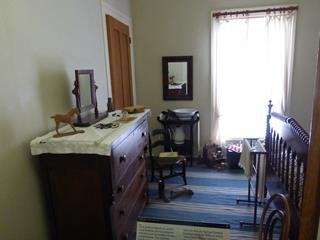
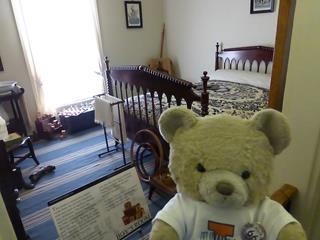
Then we saw the Hired Girl's room - this position was usually held by a fourteen or fifteen year old immigrant girls, paid $1.50 per week plus room and board, carrying out household chores. Done with the upstairs, it was time to return to the ground floor. Obviously, I had to do that by sliding down President Lincoln's handrail. Wheeee!
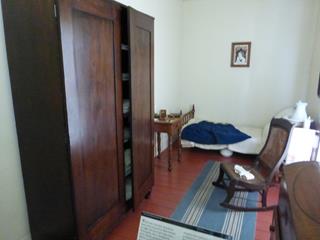
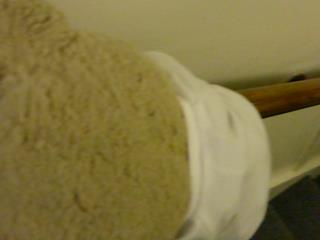
Downstairs we checked out Mary's kitchen. She had a top of the line stove and someone had just made biscuits (I am reliably informed these were fake! Booooo!!!)
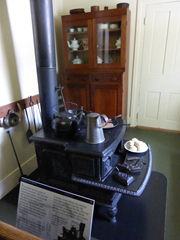
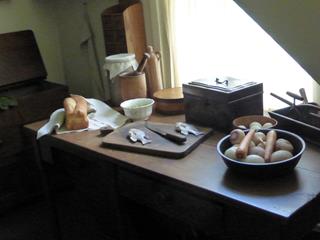
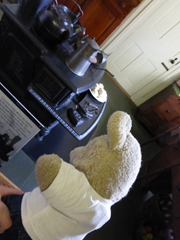
It wasn't long before we were out in the back garden. We took a look at the garden, and found a small outhouse. Bathrooms were a little more communal back then! A little more rustic too.
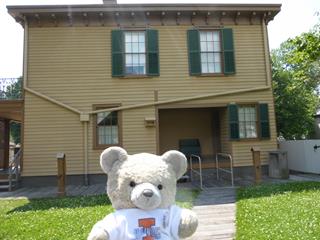
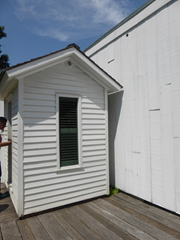
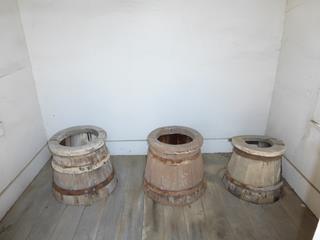
We had a few more minutes to take a look at the surrounding houses. Below left is the Charles Arnold House. The original house was built at the same time as the Lincoln House, around 1840. By 1850, Charles Arnold had bought it for $800. Changes were made over time, including brick cladding, but in the 1990s restoration work was undertaken to revert the house to its 1860 appearance.
The building below centre is the Jesse K Dubois House. Dubois lived there from 1859 to 1864 and he was a close ally of Lincoln. It was restored to its 1860 appearance in 2005. The Dean House (below right)
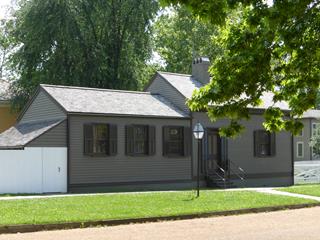
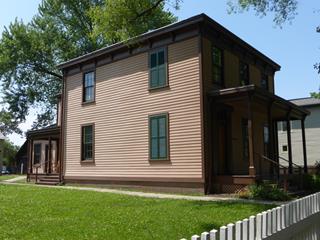
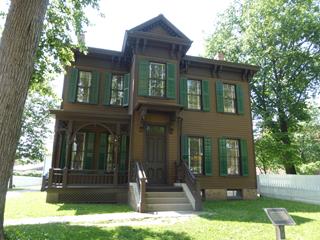
This horse-drawn model of Lincoln's childhood home - the log cabin - was used during the election campaign. I got one last picture then headed back to the Visitor Center and took a look at this small exhibit where you can touch various things from the Lincoln Home, like the furniture, wallpaper, carpet and toy soldiers.
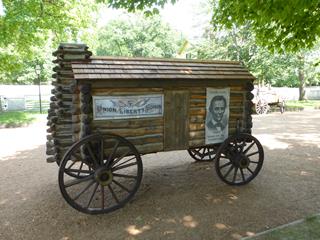
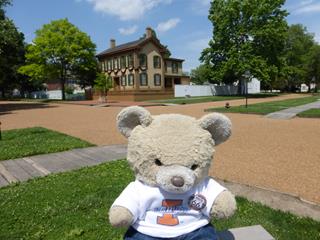
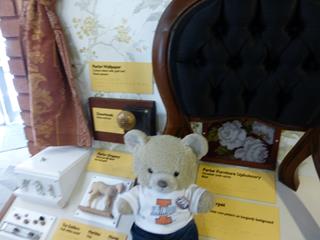
It was then a short drive over to the Lincoln Museum.



 There was a little confusion about getting off the bus and the number of booked guests but we were soon allowed to get off the bus and into the Museum - the Library (below centre), which we didn't visit, was just across the road. Once inside, one of the docents (guides) gave us a quick overview of the exhibits that we could see - Lincoln's youth, presidency, some documents and special items on loan from the Chicago Historical Society. They also have two movie theatres, though we didn't have time to fit those in!
There was a little confusion about getting off the bus and the number of booked guests but we were soon allowed to get off the bus and into the Museum - the Library (below centre), which we didn't visit, was just across the road. Once inside, one of the docents (guides) gave us a quick overview of the exhibits that we could see - Lincoln's youth, presidency, some documents and special items on loan from the Chicago Historical Society. They also have two movie theatres, though we didn't have time to fit those in!
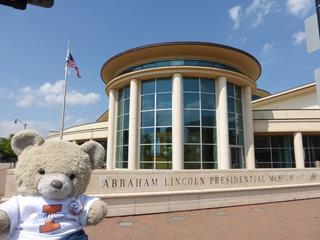
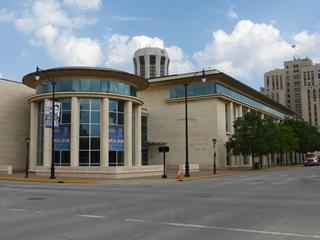
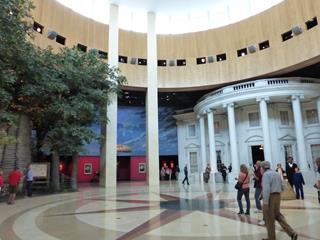
What a place! It certainly looked impressive. I grabbed a couple of shots with the Lincoln family in the Plaza before we headed into the exhibits. There are two journeys. Journey I depicting Lincoln's early years and Journey II, his time in the White House. We decided to visit chronologically, starting in Journey I, the cabin.
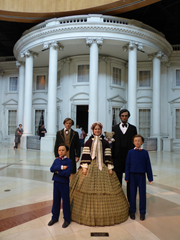
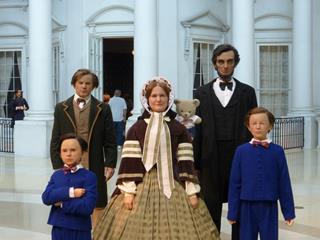
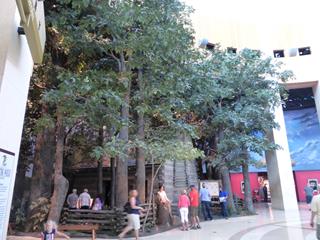
Flash photography was not permitted in the exhibits so the pictures are a little dark - I hope you can see! We found a young Lincoln sitting outside of a mockup of his cabin. As we headed into the cabin it looked great under the trees, very realistic.
While the original Lincoln family home has been lost, the one in the museum has been assembled from authentic mid-nineteenth century log cabins, being built as accurately as possible. This cabin is based on his Indiana home of 1818. It is believed that the cabin in the museum is larger than Lincoln's original, but with the extra traffic of the museum it helps.
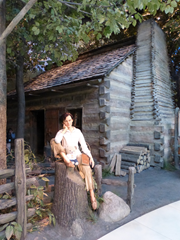
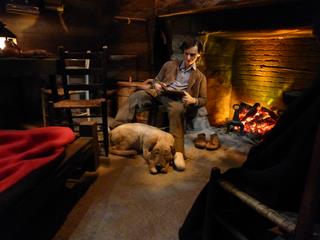
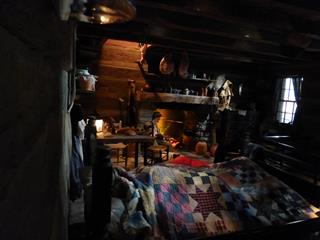
We exited the cabin to a study of slavery. In 1828, Lincoln took a trip to New Orleans. It is not known if he witnessed a slave auction as portrayed here (below left). Lincoln's first venture into business was in the Berry-Lincoln Store in New Salem (recreated below centre). In the scene, Lincoln is interacting with Ann Rutledge. It is claimed by some that she was Lincoln's first love, but it cannot be proven. She died young in 1835. Lincoln met Mary Todd (below right) at a dance, in Springfield. She was intelligent and articulate, a member of the southern aristocracy.
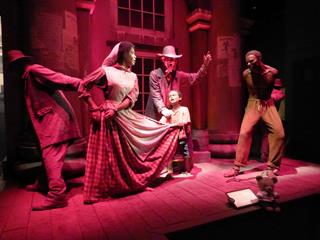
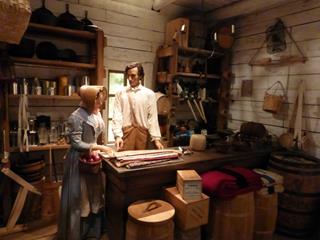
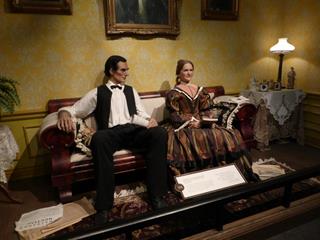
Lincoln's life in Springfield, Illinois is portrayed below. He arrived in the bustling town of 1800 inhabitants. There are some items on display from the Lincoln Home, including original drapery and wallpaper and a soapdish (below centre). In Springfield, he built his law practice with his partner, William Herndon. As depicted below right, Lincoln was pretty permissive with his sons Willie and Tad. Herndon said, "Lincoln would say nothing, so blinded was he to his children's faults."
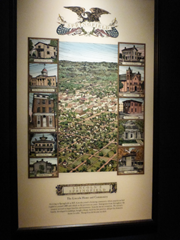
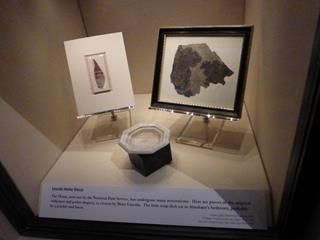
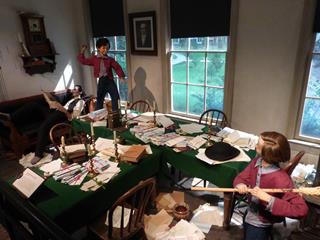
In 1860, Lincoln hit the campaign trail. It was a complex four-way presidential campaign and the Museum found an unusual way of explaining it all to a modern audience. Multiple video monitors display the issues and strategies of 1860 in modern media language. Here, a 21st Century news broadcast, hosted by NBC news legend Tim Russert, shows campaign ads for the four candidates - Abraham Lincoln, Stephen Douglas, John Breckinridge and John Bell - spinning their campaign platforms as today. What a great idea! Sadly we didn't have time to stay long, but I think you can buy the film - I need to look into that. Winning the election, the Lincoln's moved to Washington, DC. He would not return to Springfield alive.
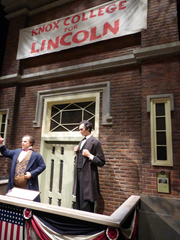
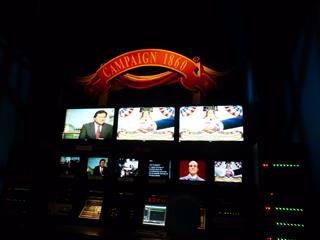
At this point we crossed over to Journey II and entered the White House. Mary Washington struggled to fit in but she fought to gain social acceptance. When Jefferson Davis left Washington DC to become President of the new Confederate States of America, his wife's dressmaker moved to the Lincolns' White House, becoming Mary's trusted friend. They also have dresses which are exact reproductions of those worn by ladies of Washington, such as Mrs Stephen (Adele) Douglas and Mrs George (Mary Ellen) McLelland - they were not too complimentary about the newest occupants of the White House.
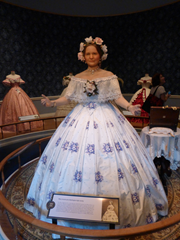
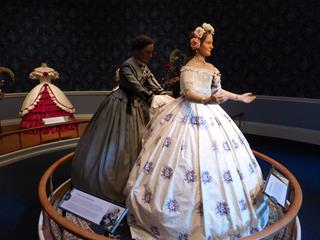
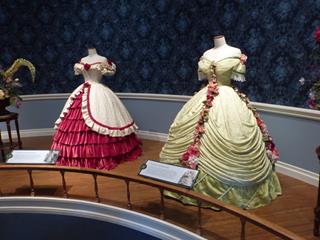
Visitors can stand with the Lincolns as they oversee their son Willie's illness. After receiving assurances that Willie was geting better, they went ahead with a lavish White House party on 5 February 1862. During the party he actually took a turn for the worse and was dead two weeks later.
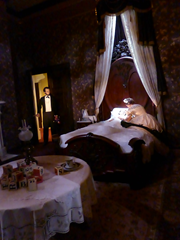
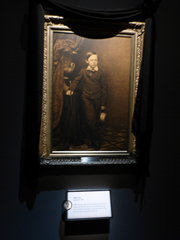
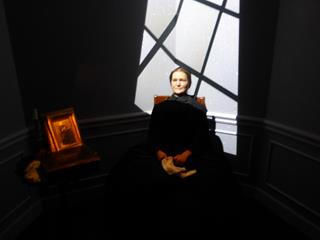
I took the time to sit in on a Cabinet meeting. The Emancipation Proclamation was discussed and debated and was very controversial. Eventually, Lincoln presented the Proclamation. The actual document can also be seen in this Museum.
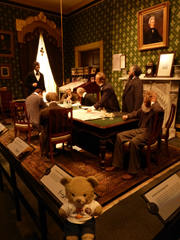
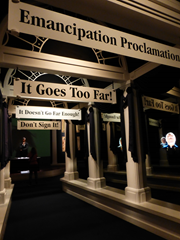
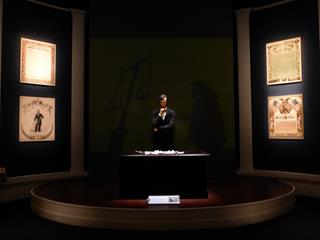
The presidential box in Ford's Theatre is recreated here, with the architecture as near to accurate to the time as is possible. At about 10.15pm, as the Lincolns watched the play, John Wilkes Booth entered the Presidential Box, his hand reaching into his jacket. He shot President Lincoln in the head with a Derringer, at point blank range. As Lincoln slumped forward, Booth leapt down to the stage and made his escape. Mary screamed.
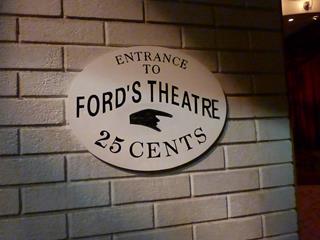
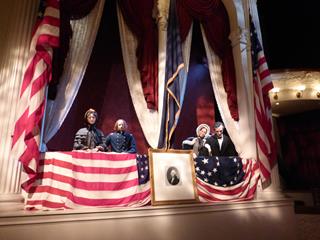
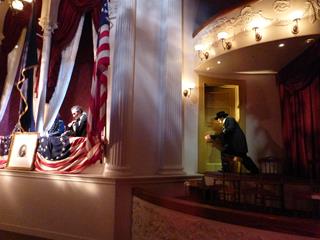
Using period photographs, reporters' descriptions, historical etchings and artist impressions of the time, the Hall recreates Lincoln lying in state. Modern visitors can file past as though paying their respects.
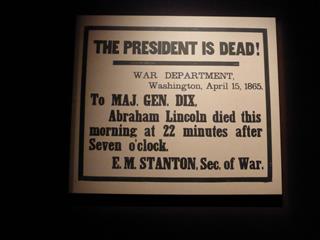
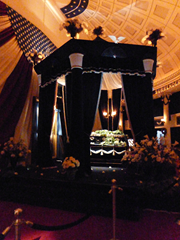
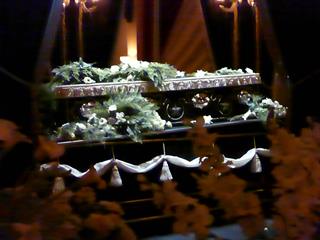
By the time we had seen the various exhibits, there wasn't really time to see the movies. To be fair, we'd left them until last as seeing the real items was more important, but, being at given times meant we had to give them a miss. We did have time to visit the gift shop though - which was very extensive. They had a load of stuff in here and yet, we didn't buy anything, and we really wanted to - I'm a big fan of Lincoln. The designs on the shirts for the humans did not appeal and - of course - you couldn't buy ted-shirts. Even the mugs, keyrings and magnets were disappointing. Either the design did not appeal, or the price was too high. They had a lot of books too, but I rarely buy books in gift shops anymore as they are so much cheaper in other outlets. We do like to buy items when the money supports the attraction, but this time they lost out.
We headed outside to wait for the bus, with just enough time to cross the road and take a picture of this Lincoln statue. Sadly, we couldn't visit the the Presidential Library which was just across the road as I would have liked a little time to take a look around. We'd been to Clinton's Presidential Library in Arkansas a couple of years earlier and thought that we ought to work on a Presidential Library check-off list. Sadly we didn't make it this time. As we boarded the bus, we noted something a little different about Beth...but what was it...?
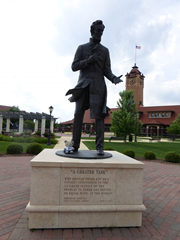
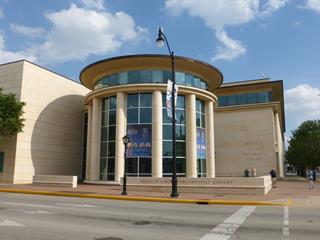
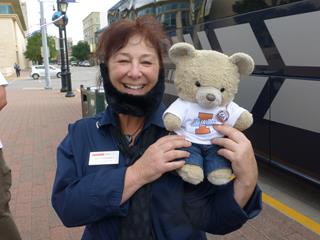
Beth said we would call for a quick photo stop at the Illinois State Capitol on the way to the hotel, which was great, as we have a check-off list for those too. Well, a mental one. We've been to quite a few over the years. We were planning to walk down to this one from the hotel later in the evening, as it wasn't that far, but this saved us some time and effort. I got you a photograph of an American fire truck as it passed.
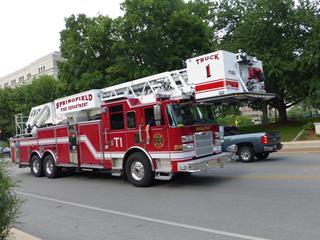
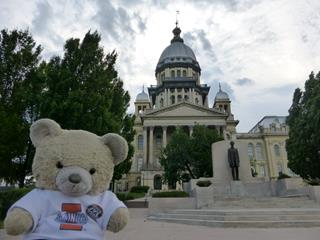
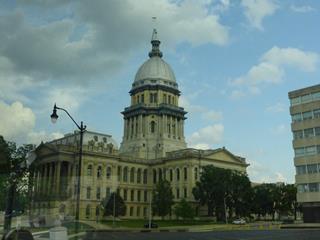
We could see there were a few statues in the grounds but we really didn't have time to check them out. It was a short photo-stop after all. The tall one with Lincoln at the top was different - a bit like a pencil topper!
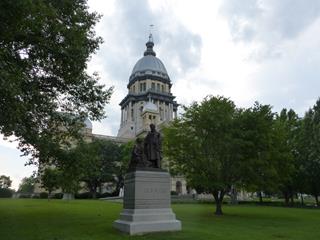
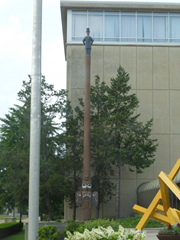
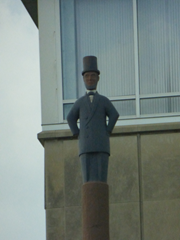
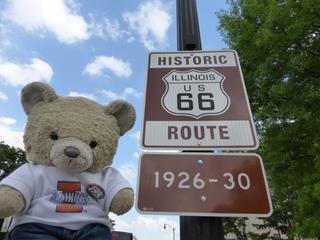
The bus drove us the short journey to the Hilton Springfield. It wasn't a bad hotel - tall, like a wheel axle. The room had two beds, flat screen TV, desk, coffee maker, ice bucket, all the usual stuff.
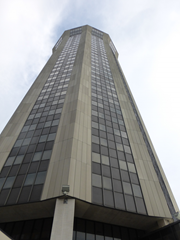
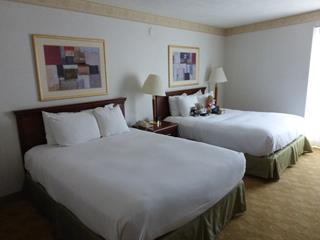
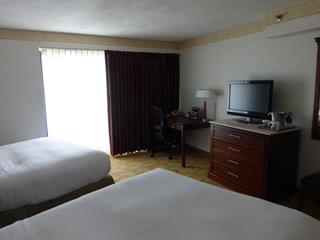
Our room was pretty high up - and overlooked our bus. Abe was just on the wall across the road. The sky had become overcast again so we weren't sure what we'd encounter as we went out for dinner. The wind had picked up and a few folks had mentioned the T-word as we were driving through Tornado Alley - an area of the country with a relatively high concentration of tornadoes - we didn't need to see one of those!
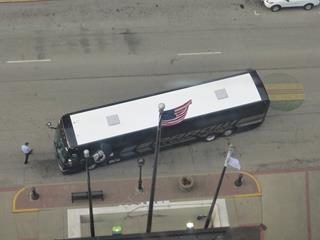
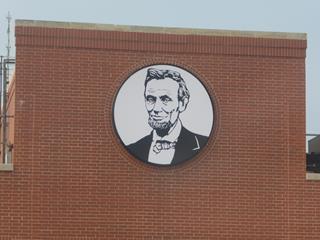
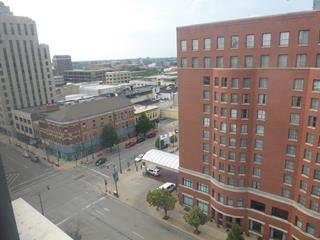
We saw some offices where Lincoln practised law. He wrote his first inaugural address on the third storey of this building when he became President. He arrived in Springfield in 1837 as a 28-year old, unmarried, unrefined man, with little to his name in a town of 2,000 people. When he left, aged 52, he was married, with children and financially secure in a city of 10,000 people.
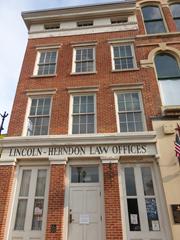
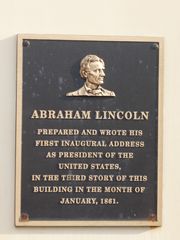
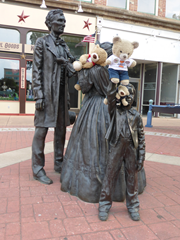
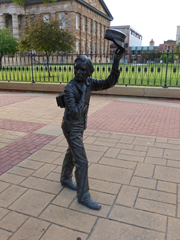
We took a look at the Old State Capitol. The cornerstone of Illinois's fifth Capitol was laid in 1837. At the ceremony, Lincoln's close friend Springfield lawyer Edward D Baker was principal speaker. The Capitol was eventually completed in 1853. It was the most imposing state capitol in the west for many years. Lincoln argued cases before the Supreme Court which met in here and also first confronted Stephen A Douglas, his presidential rival in 1860. Lincoln made his "House Divided" speech and he retained an office here after being elected President. In May 1865, Lincoln's body was laid to rest here, before burial at Oak Ridge.
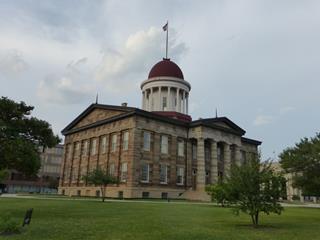
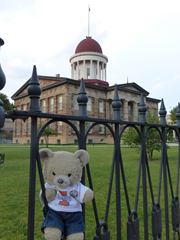

We headed through town to look for a place for dinner. We had a place in mind that we'd found on the internet and headed that way. We passed by the Post Office and Court House. We passed Christ Church (below centre) and in the distance we spotted the new Capitol Building.
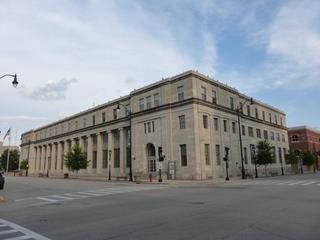
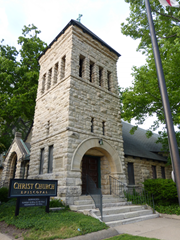
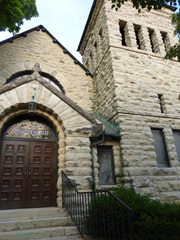
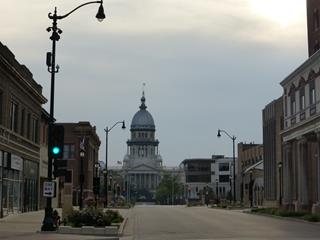
We arrived at Obed and Isaac's Microbrewery.


 They met all the criteria - local beer and a veggie burger for the assistant. We got there and it was pretty busy. They said it would be about a 25 minute wait so we went to the bar and ordered some drinks and then sat outside to peruse the menu. Theo ordered an Upside Coffee Brown Ale, I had an Obed's House Cider and Frank ordered a Strawberry Blonde Ale (that Theo seems to be drinking!)
They met all the criteria - local beer and a veggie burger for the assistant. We got there and it was pretty busy. They said it would be about a 25 minute wait so we went to the bar and ordered some drinks and then sat outside to peruse the menu. Theo ordered an Upside Coffee Brown Ale, I had an Obed's House Cider and Frank ordered a Strawberry Blonde Ale (that Theo seems to be drinking!)
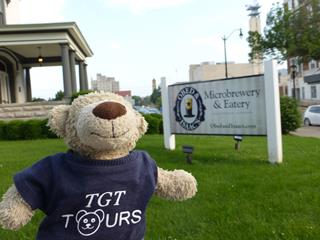
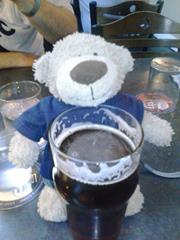
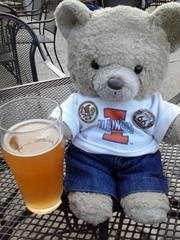
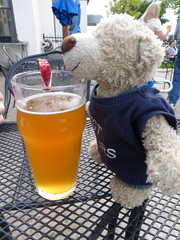
It wasn't long before we were called to our table and ordered our food. It was a little slow to arrive, but when it did it was very good. One of the ladies on the bus - Laura - had mentioned a Horseshoe burger as being a local specialty. Di got a Horseshoe Veggie Burger (below right), which was an open-face sandwich with thick sliced toasted bread, veggie burger (or you could have a meat burger - with sirloin steak, ham, chicken breast, corned beef, buffalo chicken, turkey burger, smoked turkey, pulled pork or lamb!), smothered with a secret cheese sauce and then topped with fries. A smaller Pony Shoe was also available. It was pretty darned good. My buddies Frank and Theo had the Beer and Whiskey Burger with beer-braised onions, mushrooms and smoked gouda cheese.
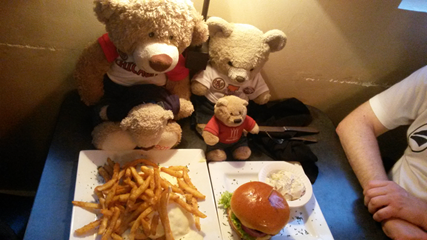

We had some more beers too, working our way through the menu of local options with (left to right) an Isaac's IPA, a Ditzy Blonde Ale and Obed's Amber Ale. Although a little slow, the service was pleasant enough, so they got four Teds.
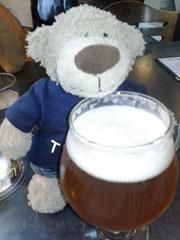
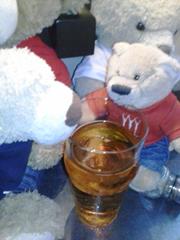

We walked back to our hotel - it still wasn't raining, but it was getting dark. Fortunately it wasn't far though and we were soon back in our room. We hadn't been in long when we looked out of our room window and there was a heck of a storm going on. It was pouring with rain, though unless a tornado hit, we wouldn't care. We were pretty tired too, so maybe we wouldn't notice even then.
Return to previous day ~~~ Go to next day
comments powered by Disqus